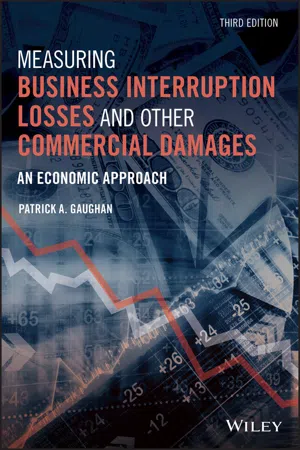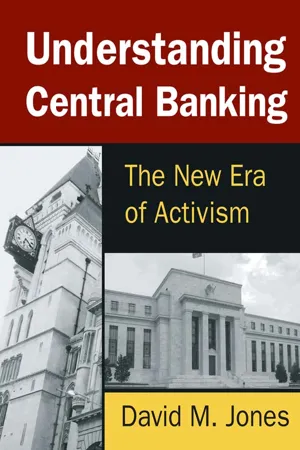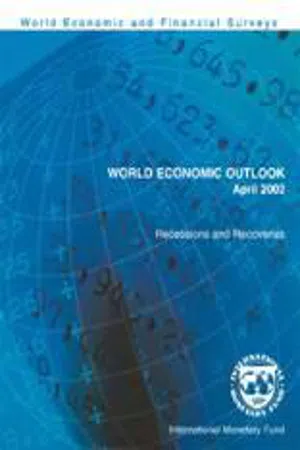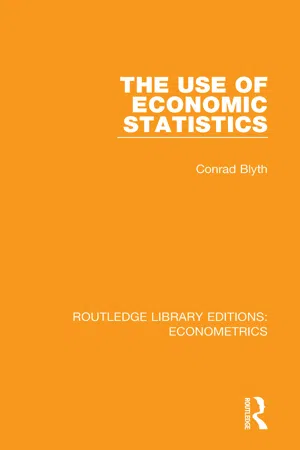Economic Contraction
Economic contraction refers to a period of decline in a country's economic activity, typically measured by a decrease in gross domestic product (GDP) over two consecutive quarters. This phase is characterized by reduced consumer spending, lower business investment, and rising unemployment. It often leads to decreased production, lower incomes, and overall economic hardship.
7 Key excerpts on "Economic Contraction"
- eBook - ePub
Economics for Investment Decision Makers
Micro, Macro, and International Economics
- Christopher D. Piros, Jerald E. Pinto(Authors)
- 2013(Publication Date)
- Wiley(Publisher)
...The contraction—often called a recession, but may be called a depression when exceptionally severe—is a period in which aggregate economic activity is declining (although some individual sectors may be growing). Business cycles are usually viewed as fluctuations around the trend growth of an economy, so such points as peaks and troughs are relative to the individual cycle. Exhibit 6-1a shows a stylized representation of the business cycle, and Exhibit 6-1b provides a description of some important characteristics of each phase. The description distinguishes between early and late stages of the expansion phase, which are close to cycle turning points. Exhibit 6-1b also describes how several important economic variables evolve through the course of a business cycle. EXHIBIT 6-1a Schematic of Business Cycle Phases EXHIBIT 6-1b Characteristics The behavior of businesses and households frequently incorporates leads and lags, relative to what are established as turning points in a business cycle. For example, unemployment may not start decreasing immediately after the expansion phase starts because companies may want to fully use their existing workforces and wait to hire new employees until they are sure that the economy is indeed getting better. However, gradually all economic variables are going to revert toward their normal range of values (e.g., GDP growth will be a positive number). If any countercyclical economic policies were adopted during the recession, they would be gradually phased out; for example, if the central bank reduced interest rates to fight the recession, it should start increasing rates toward their historical norms. Central banks are the monetary authority in most modern economies. During a recession, investors place relatively high values on such safer assets as government securities and shares of companies with steady (or growing) positive cash flows, such as utilities and producers of staple goods...
- eBook - ePub
Recession Prevention Handbook
Eleven Case Studies 1948-2007
- Norman Frumkin(Author)
- 2017(Publication Date)
- Routledge(Publisher)
...A recovery has begun when the economy stops declining and turns upward. An expansion occurs when the upward recovery exceeds the level of the previous expansion. Recession and contraction refer to falling phases of a business cycle. If, from the high point of an expansion, the economy turns downward with persistent declines in production and employment and increases in unemployment, then a recession has set in. In rare cases, when the decline in production and employment falls below the low point of the previous recession, a contraction has set in. The last contraction extended the 1981–82 recession. The high point of an expansion is referred to as the “peak,” and the low point of a recession/contraction is referred to as the “trough.” Figure 1.1 depicts these generic phases of the business cycle. It is important to note that a recession signifies an actual decline in production and employment. By contrast, a recession is not present when there is a decline solely in the rate of growth of production during an expansion (what mathematicians call a “second derivative”). This is referred to as a growth recession. A last term that fortunately has not arisen since the 1930s is “depression.” A depression is a collapse of the economy affecting people in all social and economic strata, with mass unemployment, the widespread loss of assets such as homes and life savings, the disappearance of businesses through bankruptcy, and the undermining of the financial system through failures of the banking, securities, and insurance industries. A depression is far more devastating than a recession. 4 For example, unemployment rose to about 25 percent in the Depression of the 1930s, compared with unemployment highs of 9 percent to 11 percent in the severe recessions of 1973–75, 1981–82, and 2007–9 and their subsequent recoveries. There is no systematic formula or model that determines the onset or the end of a recession/contraction...
- eBook - ePub
Contemporary Economics
An Applications Approach
- Robert Carbaugh(Author)
- 2016(Publication Date)
- Routledge(Publisher)
...Then national output declines, profits and real incomes decrease, and the unemployment rate increases to uncomfortably high levels as many workers lose their jobs. Eventually, the Economic Contraction vanishes and recovery begins. The recovery may be slow or fast. It may be partial, or it may be so strong that it results in a new era of prosperity. Or it may be characterized by escalating inflation, soon to be followed by another downturn. The upward and downward movements in output, employment, and inflation form the business cycle that characterizes all market economies. Phases of the Business Cycle The term business cycle refers to recurrent ups and downs in the level of economic activity over several years. Although business cycles may vary in intensity and duration, we can divide each into four phases, as shown in Figure 11.2. Peak. At the peak of a business cycle, real GDP is at its highest point. Employment and profits are usually strong. Recession. A recession is a period of significant decline in total output, income, employment, and trade, that usually lasts from 6 months to a year and is marked by widespread contraction in many sectors in the economy. A recession begins at a peak and ends at a trough. For example, the U.S. economy began the Great Recession in December 2007, which lasted until June 2009. A typical recession boosts the unemployment rate up more than three percentage points. Even small recessions increase the unemployment rate more than two points. Trough. The low point of real GDP, just before it begins to turn upward, is called the trough of a business cycle. At the trough, unemployment and idle productive capacity are at their highest levels relative to the previous recession. The trough may be short-lived or quite long. Recovery. Recovery is an upturn in the business cycle during which real GDP rises...
- eBook - ePub
Measuring Business Interruption Losses and Other Commercial Damages
An Economic Approach
- Patrick A. Gaughan(Author)
- 2020(Publication Date)
- Wiley(Publisher)
...Within the field of macroeconomics, there is a subfield called business fluctuations that analyzes the various factors in the economy that cause it to grow and contract. These business fluctuations are referred to as business cycles. The term “cycles” is unfortunate since it implies a periodicity such as that of a sine curve. Exhibit 3.1 features the usual textbook presentation of a business cycle; it shows an expansion phase that reaches a peak followed by a downturn, usually referred to as a recession. However, the economy does not behave in such a predictable manner. Moreover, the economics profession has not been very successful in predicting the turning points of business cycles. Definition of a Recession When the economy turns down and exhibits negative growth, this is termed a recession. Exhibit 3.2 depicts the 1990–91, 2001, and 2008–09 recessions. As mentioned earlier, recessions are generally defined as periods when economic growth is negative. EXHIBIT 3.2 Examples of the 1990–91, 2001, and 2008–09 recessions. Source: U.S. Department of Commerce, Bureau of Economic Analysis, Washington, DC, NBER. A simple definition of a recession, one that is often used by the media, is a period when there are two consecutive quarters of negative growth. Recessions, however, are defined on a case‐by‐case basis by the Business Cycle Dating Committee of the National Bureau of Economic Research (NBER) using a variety of economic data to make this determination. 2 This is a group of six economists, ones who specialize in macroeconomics and business fluctuations, who essentially make a judgment call based on their review of a variety of economic data. They look at more than simply real gross domestic product (GDP) growth; they also consider factors such as employment, personal income, manufacturing, and industrial production. 3 Table 3.1 shows the recessions that occurred in the U.S. economy between 1948 and 2009. The average duration of a recession is 10.4 months...
- eBook - ePub
Understanding Central Banking
The New Era of Activism
- David M Jones(Author)
- 2014(Publication Date)
- Routledge(Publisher)
...Appendix II Recessions (Contractions), Depressions, and Panics Dr. David M. Jones, FIN 6246 Money and Capital Markets, January 26, 2011 The commonly accepted definition of a recession (contraction) is two or more consecutive quarters of decline in real GDP. But I prefer the broader yet more meaningful definition of recession (contraction) offered by the National Bureau of Economic Research (NBER), which officially dates our cycles. The NBER defines a recession (contraction) as a significant decline in economic activity spread across the economy, lasting more than a few months (see http://www.nber.org/cycles.html). The NBER observes that recessions (contractions) are normally visible in such key economic indicators as real GDP, real income, employment, industrial production, and wholesale-retail sales. There is no commonly accepted definition of a depression. It has been said that a recession (contraction) is when someone else is unemployed, and a depression is when you are unemployed. My definition of a depression is admittedly somewhat arbitrary. I contend that a depression can be defined as a recession (contraction) that lasts more than 3 years (36 months). At their core, financial panics or crises involve a collective loss of confidence in the financial system. The resulting periodic depositor runs on banks causing numerous failures were commonplace prior to the establishment of the Federal Reserve in 1913. These panics or crises typically follow periods of rapid economic growth, financial excess, credit-fueled speculation, and stock price bubbles. The Federal Reserve was established largely in response to the Panic of 1907. The primary aim of our nation’s central bank was to serve as a backstop for the U.S. financial system or as a lender of last resort when a panic or crisis occurs...
- International Monetary Fund. Research Dept.(Author)
- 2002(Publication Date)
- INTERNATIONAL MONETARY FUND(Publisher)
...Analyzing the latter often requires the application of cumbersome nonlinear statistical methods (e.g., Diebold and Rudebusch, 1999). However, recent advances in econometrics and information technology have greatly facilitated the use of nonlinear models in empirical economic research. 6 See, for example, Boone and others (2002). 7 In some macroeconomic models, the same shock may affect both long-run growth and business cycle fluctuations. See King and others (1991), among others. 8 Classical recessions typically overlap with growth recessions, while the converse is not true. 9 Looking forward, as the working age population in many industrial countries starts to decline, level recessions will no longer be so severe in per capita terms. For the analysis, a recession is defined as one or more consecutive years of negative real GDP growth, while an expansion consists of a year or more of positive growth. The resulting business cycle turning points broadly match the dates in the National Bureau of Economic Research (NBER) chronologies for the United States, the United Kingdom, France, and Germany (available in Glasner, 1997). The differences reflect the use by the NBER of higher frequency (monthly) data and a broader variety of indicators, such as employment, bank clearings, and department store sales. Also, since the analysis in this section uses annual data, differences might arise regarding the dating of business cycles, compared to the following section, which uses quarterly data. Recessions Are Becoming Milder and Less Frequent Recessions have become less severe and less frequent over time (Table 3.1). During the prewar period, the average decline in real GDP from peak to trough was 4.3 percent, and recessions in the United States were on average deeper than in the United Kingdom, owing in part to greater financial instability in the United States, which did not have a central bank...
- eBook - ePub
- C. A. Blyth(Author)
- 2018(Publication Date)
- Routledge(Publisher)
...Quite apart from the meaning and importance of unemployment in the two countries because of differences in the mobility of labour, the percentages are measuring differing things. The student is warned! What we are going to do in this chapter is to show how some of the most accessible American statistics can be used to describe and explain the development of the American economy since the war. We do this by studying the fluctuations in economic activity as revealed by the index of industrial production and the quarterly constant price national income statistics. The fluctuations—sometimes called the trade or business cycle—are discussed in relation to the political and other economic events of the times, and also in relation to the long-term growth in American economic activity. Undoubtedly in the short space of a chapter many of the reader's questions will be left unanswered: the remedy lies in the American statistical sources in his own hands. 2. Expenditure and output in Periods of Contraction and Expansion TABLE 12.1 Peaks and Troughs in American Business Activity, 1948-58 Since the end of the Second World War there have been four periods of expanding business activity in the United States (including the most recent revival after the 1957-8 recession) broken by three short but sharp contractions. The peaks and troughs in industrial production are shown in Table 12.1 (and also in Chart 12.1). For the table and the following analysis the peak of an expansion is defined as that quarter after which the index of production ceased to rise, and the trough of a contraction is that quarter after which the index ceased to fall. Monthly data would, of course, show larger proportionate falls during the slumps. No great precision is aimed at in this dating—it is no more than an attempt to classify the main characteristics of business activity over time...






